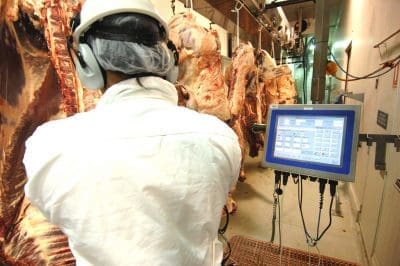RECENT falls of 25-75mm across large parts of the three eastern mainland states, and prospects of a lot more to come later this week is disrupting supply of slaughter cattle for processors in many areas.
A number of large export processing plants are dropping days this week and anticipate doing the same next week, as the accumulation of recent rain makes cattle work difficult and transport operations challenging.
 The weather had a clear impact on Roma store sale this morning, where numbers crashed to just 2200 head, down by 3700 head on the week before, due to falls across the supply area of anywhere from 25mm to 100mm in places. The market was fully firm to dearer, observers at the sale told Beef Central.
The weather had a clear impact on Roma store sale this morning, where numbers crashed to just 2200 head, down by 3700 head on the week before, due to falls across the supply area of anywhere from 25mm to 100mm in places. The market was fully firm to dearer, observers at the sale told Beef Central.
Processors have said the rain is playing havoc with trucking slaughter stock this week, with cancellations of booked cattle common. That’s likely to extend into next week, exacerbating things further. Some cattle may not be able to load for another week or more, one processor said.
Come back tomorrow for Beef Central’s weekly rainfall wrap, and Roma store report.
Long grass-growing season
As BOM’s predictions of a wet spring and early summer turn into reality in many areas, some key cattle regions are facing one of the longest summer grass-growing seasons in recent memory. Areas that missed out earlier, such as some parts in Central Queensland have now received good rain this week and cattle will begin to gain weight. Large areas of cattle country in NSW now have a full moisture profile and dams are full. Any further rain will only run off in some areas, Beef Central was told.
It’s led to some speculation about how the opening passage for the 2022 slaughter season might unfold.
One large multi-site export processor told Beef Central this morning that if it continues, and there are no serious rain disruptions limiting access, the conditions could push cattle to market a month or two earlier than normal in the early stages of 2022. In Queensland, March and April normally triggers the start of heavy turnoff, but that could easily shift forward to February next year, the processor said.
“But you can only kill them once. Bringing a few cattle forward might help the immediate problem, but it still leaves a gap to fill later in the year, and next year is shaping up to still be very tight, supply-wise,” he said.
The processor also felt average turnoff weights for grassfed cattle throughout the year could benefit from what’s shaping as an outstanding season, north to south.
Grids steady
Best offers among competitive southern Queensland processors on four-tooth heavy grass ox seen this morning remain at 790c/kg, with several others sticking to last week’s rates of 780-785c.
Heavy cows in Queensland are now closely grouped around 750c, with some operators lifting their earlier offers 20c to match competitors last week.
Central Queensland rates are currently similar to southern parts of the state.
In Victoria/South Australia, direct consignment slaughter grids now closely match those seen in Queensland, with best cow prices cows around 750c/kg and heavy grass steers anywhere from 780-830c. NSW rates may be 20-30c behind that.
A few new-season slaughter cattle are starting to flow out of the New England region, processors commented this morning, but Riverina cattle are proving very slow to come to market this spring, as producers aim to add as much weight as possible, given the season.
Closure dates are now beginning to be posted for the annual Christmas shutdown. Teys has scheduled last kill for its Biloela plant in Central Queensland for Thursday, 2 December; Lakes Creek will kill as late as it can towards 23 December, subject to weather; and Beenleigh will drop its second shift from 22 December, re-starting 10 January. Teys southern plants will work through, barring public holidays. More plant closure dates will be added in future weekly kill reports.
Slaughter eases
National slaughter for the week ended Friday slumped sharply, with much of the impact recorded in Queensland.
The national total for the week reached 97,083 head, down another 3000 head or 3pc on the week before. As described above, rain had an impact in some cattle catchment areas.
Queensland numbers continued to fall, reaching 48,699 head, down 2.4pc on the previous week and back almost 10pc on the kill before that.
NSW numbers eased 1pc to 28,162 head, while Victoria eased 2.5pc to 11,659 head, impacted a little by Melbourne Cup Day holiday. Tasmania recorded a big 17pc decline to 2789 head, while South Australian processors eased slightly to 2957 head.
